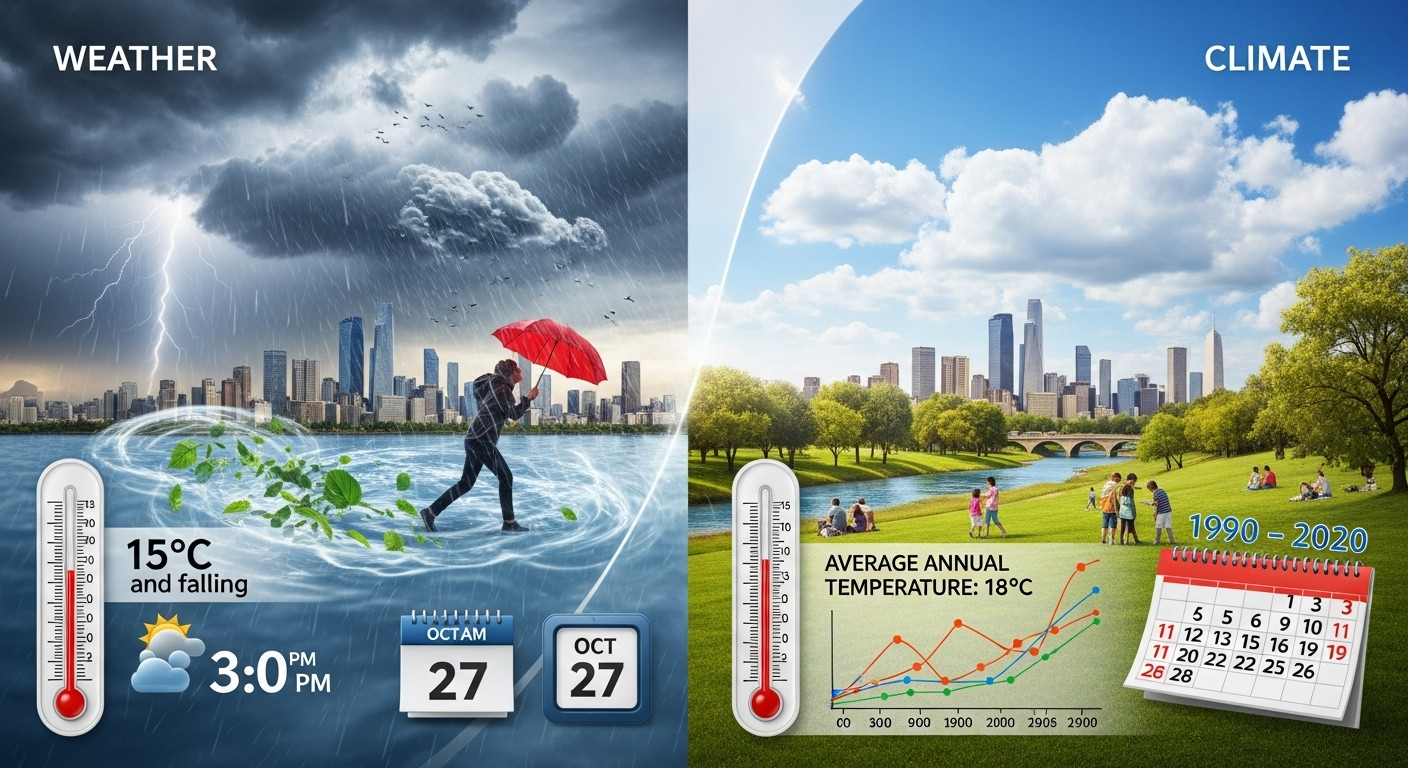Of course. As an SEO expert, I will craft a comprehensive, unique, and engaging article on the difference between weather and climate, optimized for modern search engines and long-term relevance.
Here is the article:
—
You’re planning a vacation to a tropical island six months from now. What do you pack? Shorts, t-shirts, and swimwear seem like a safe bet. But what if you’re traveling there tomorrow and the local forecast calls for an unusual cold snap with heavy rain? You'd pack a jacket and an umbrella. This simple scenario perfectly illustrates the fundamental concept you need to grasp in order to understand the difference between weather and climate. One is about the immediate conditions you'll face, while the other is about the long-term patterns you can expect. They are two sides of the same atmospheric coin, yet they describe vastly different scales of time and impact, and confusing them can lead to significant misunderstandings about our world.
Table of Contents
ToggleWhat is Weather? The Short-Term Atmospheric Condition
Weather is what's happening in the atmosphere right now or over a very short period—minutes, hours, days, or even a week. It is the immediate, tangible experience you have when you step outside. Is it sunny, cloudy, windy, or calm? Is it raining, snowing, or hailing? These are all questions about the weather. It is dynamic, constantly changing, and can vary significantly from one city to the next, or even one part of a city to another. Think of weather as the atmosphere's daily mood—it can be bright and cheerful one moment and dark and stormy the next.
This "mood" is determined by a complex interplay of several atmospheric variables. The heat from the sun acts as the engine, driving movements in the air and water that create the events we experience. A high-pressure system might bring clear skies and calm conditions, while a low-pressure system is often associated with clouds, wind, and precipitation. These systems are in constant motion, which is why the weather forecast for Monday can look completely different from the forecast for Wednesday.
The science of studying and predicting these short-term conditions is called meteorology, and the scientists who practice it are called meteorologists. They use an array of sophisticated tools to gather data and build complex computer models. Their goal is to provide the most accurate forecast possible so you know whether to pack that umbrella, postpone a picnic, or prepare for a severe storm. But their focus remains on the near future, typically up to about 10 days out, because the chaotic nature of the atmosphere makes detailed predictions beyond that timeframe highly unreliable.
The Key Elements of Weather
To properly define weather, it’s essential to understand its core components. These are the specific, measurable variables that meteorologists track to describe the state of the atmosphere at a given location and time. They are all interconnected, and a change in one can quickly trigger changes in the others.
The most common elements of weather include:
- Temperature: How hot or cold the air is, measured with a thermometer.
- Precipitation: Water falling from the atmosphere to the Earth's surface. This can be in liquid form (rain) or solid form (snow, sleet, hail).
- Humidity: The amount of water vapor present in the air. High humidity on a hot day can make it feel much more oppressive.
- Wind Speed and Direction: The movement of air from high-pressure areas to low-pressure areas.
- Atmospheric Pressure: The weight of the air pressing down on the Earth. Changes in pressure are a key indicator of coming weather changes.
- Cloud Cover: The fraction of the sky obscured by clouds. This affects how much sunlight reaches the ground.
These elements combine to create the specific weather events we experience. For example, low atmospheric pressure, high humidity, and falling temperatures are the perfect ingredients for a rainstorm. On the other hand, high pressure often leads to sinking air, which prevents cloud formation and results in sunny, clear days. Understanding these individual ingredients is the first step in understanding the complex recipe that is our daily weather.
How is Weather Measured and Forecasted?
Predicting the weather is a monumental task that blends observational data with immense computing power. Meteorologists begin by collecting as much real-time data as possible from a vast global network. This includes data from weather stations on the ground measuring temperature and pressure, weather balloons (radiosondes) that collect data as they rise through the atmosphere, radar systems that detect precipitation, and weather satellites that provide a bird's-eye view of cloud patterns and storm systems.
All of this data is then fed into supercomputers that run incredibly complex numerical weather prediction (NWP) models. These models use the laws of physics and fluid dynamics to simulate how the atmosphere will evolve over the next several hours and days. Because the atmosphere is a chaotic system—meaning small initial uncertainties can lead to vastly different outcomes—forecasters run multiple simulations (an "ensemble forecast") with slightly different starting conditions. If most of the simulations show a similar outcome, confidence in that forecast is high. If they diverge wildly, the forecast is considered uncertain. This is why a forecast is often given in percentages, like a "30% chance of rain."
What is Climate? The Long-Term Atmospheric Pattern
If weather is the atmosphere's mood, then climate is its personality. Climate is the average of weather conditions over a long period, typically 30 years or more, for a specific region. It's about expectations, not surprises. You expect the Amazon rainforest to be hot and humid, and you expect Antarctica to be frigid and dry. This expectation is based on decades of aggregated weather data. Climate tells you what kind of clothes you should have in your wardrobe in general, while weather tells you what you should wear today.
Climate is determined by a wider set of factors that are much more stable than the daily drivers of weather. These include latitude (how far a location is from the equator), altitude (how high it is above sea level), proximity to large bodies of water (which moderate temperatures), and prevailing ocean currents and wind patterns. These factors work together over long timescales to establish the overall environmental character of a region, from the arid conditions of the Sahara Desert to the temperate, four-season pattern of New England.
The science dedicated to the study of these long-term patterns is called climatology, and its practitioners are climatologists. They aren't concerned with whether it will rain next Tuesday. Instead, they analyze historical data to identify trends, understand long-term cycles, and predict how the overall system might change over decades and centuries. When you hear discussions about "global warming" or an "ice age," you're in the realm of climate, not weather.
Understanding Climate Averages and Normals
To define the climate of a place, scientists need a standardized benchmark. The World Meteorological Organization (WMO) has established that a period of at least 30 years is necessary to calculate a "climate normal." This 30-year average helps to smooth out any short-term fluctuations or unusual years, providing a stable and reliable picture of a region's typical conditions. For example, a climatologist might calculate the average temperature, total rainfall, and number of sunny days for London for every month of the year, based on data from 1991 to 2020.
These "normals" serve as a crucial baseline. They allow us to determine if a particular day, month, or year was unusually warm, cold, wet, or dry compared to what is expected. When a news report states that "last month was the hottest July on record," it means the average temperature for that month was higher than any other July in the entire historical data set, and significantly above the 30-year climate normal. These normals are typically updated once every decade to reflect the most recent 30-year period, which is essential for tracking ongoing changes in the climate system.
Major Climate Classifications
The world is a tapestry of different climate zones, each with its own unique characteristics. To make sense of this diversity, scientists have developed various classification systems. The most widely used is the Köppen-Geiger climate classification system. It categorizes the world's climates based on specific criteria for annual and monthly temperature and precipitation patterns. This system helps us understand global patterns of vegetation, agriculture, and human settlement.
The system divides climates into five main groups, each represented by a letter:
- A – Tropical Climates: Consistently hot and humid year-round with high levels of precipitation (e.g., Amazon Rainforest, Indonesia).
- B – Dry Climates: Evaporation exceeds precipitation, leading to arid or semi-arid conditions (e.g., Sahara Desert, Australian Outback).
- C – Temperate Climates: Have distinct warm and cold seasons, with moderate temperatures and no extremes (e.g., Western Europe, Southeastern United States).
- D – Continental Climates: Also have distinct seasons but with more extreme temperature differences between summer and winter. They are typically found inland, away from the moderating influence of oceans (e.g., Russia, Canada).
- E – Polar Climates: Extremely cold year-round, with the warmest month having an average temperature below 10°C (50°F) (e.g., Antarctica, Greenland).

Weather vs. Climate: A Head-to-Head Comparison
While intrinsically linked, weather and climate are defined by their fundamental differences in time, scale, and predictability. Understanding these distinctions is the key to interpreting atmospheric science correctly. The simplest analogy remains the most effective: Weather is what you get, and climate is what you expect.
A cold day in the summer is a weather event. The fact that summers are generally hot and winters are generally cold is the climate. A single, record-breaking snowstorm in a city that rarely sees snow is an interesting weather phenomenon. But if that city starts experiencing snow every few years, and then every year, that could signal a change in its climate pattern. The following table breaks down the core differences in a clear, comparative format.
| Feature | Weather | Climate |
|---|---|---|
| Timescale | Short-term (minutes, hours, days, weeks) | Long-term (decades, centuries, millennia) |
| Geographic Scale | Local or regional (a city, a small state) | Regional or global (a continent, the entire planet) |
| Governing Science | Meteorology | Climatology |
| Measurement | A snapshot of current atmospheric variables | The statistical average of weather variables over 30+ years |
| Predictability | High in the very short term (1-3 days), decreases significantly after 7-10 days due to chaotic nature | Highly predictable for general patterns; future trends are projected based on forcing factors like greenhouse gases |
| Example | "It will be a sunny 25°C in Paris tomorrow." | "Paris has a temperate climate with warm summers and cool winters." |
| Analogy | A person's mood on a given day | A person's overall personality |
The Interconnected Relationship: How Climate Influences Weather
You cannot have weather without climate, and climate is composed entirely of weather. Their relationship is deeply interconnected. Climate essentially sets the stage or provides the boundary conditions within which daily weather can operate. A region's climate determines the type of weather that is possible and the probability of certain weather events occurring.
For example, the polar climate of Antarctica makes a 30°C (86°F) day a virtual impossibility. The climate system there simply does not allow for it. Conversely, the tropical climate of Singapore makes a snowstorm equally impossible. The climate, therefore, acts as a framework, creating a set of rules for the weather. It dictates the fundamental character of a place, ensuring that while day-to-day weather fluctuates, it does so within a predictable range of possibilities.
This relationship is most critical to understand in the context of climate change. A change in the long-term average (climate) directly alters the odds and intensity of short-term events (weather). Think of it like loading a pair of dice. A normal die has an equal 1/6 chance of landing on any number. But if you "load" the die to favor the number six, you won't roll a six every time, but you will roll it much more frequently over many attempts. Climate change "loads the dice" for certain types of extreme weather, making them more probable and more intense when they do occur.
Climate Change and Extreme Weather
One of the most significant consequences of a warming global climate is the observed increase in the frequency and intensity of extreme weather events. It's a common point of confusion: how can a single storm or heatwave be linked to a long-term trend? Climatologists are careful not to attribute any single event solely to climate change. That's a weather event. However, they can confidently say that a warmer climate makes these events more likely and/or more severe.
Here’s how it works:
- More Intense Heatwaves: As the baseline average temperature rises, a normal heatwave becomes hotter, and extreme, record-breaking heat becomes more common. What was once a 1-in-100-year heat event might become a 1-in-10-year event.
- Heavier Rainfall and Flooding: A warmer atmosphere can hold more moisture (about 7% more for every 1°C of warming). This means that when it does rain, there is more water available to fall, leading to more intense downpours and an increased risk of flash flooding.
- More Severe Droughts: While some areas get wetter, others get drier. Higher temperatures increase evaporation from soil and reservoirs, intensifying drought conditions in regions that are already prone to dryness.
- Stronger Hurricanes: Hurricanes draw their energy from warm ocean waters. As sea surface temperatures rise due to climate change, hurricanes have more fuel available, allowing them to become more powerful and intensify more rapidly.
Therefore, while the existence of hurricanes, droughts, and heatwaves is a natural part of the weather system, the increasing power and frequency of their most extreme versions are a direct consequence of a changing global climate.
Why Understanding the Difference Matters
The distinction between weather and climate is not just a matter of scientific semantics; it has profound real-world implications. Confusing the two can lead to poor decision-making at every level, from the individual to international policy. A clear understanding is vital for navigating our world and planning for the future.
On a personal level, you use this distinction all the time, perhaps without realizing it. You check the weather forecast to decide if you need a jacket today. You research the climate of a destination to plan a vacation for next year. A farmer relies on the stability of the regional climate to know which crops to plant and when, but they use the daily weather forecast to decide when to harvest or irrigate.
On a societal and global scale, the distinction is even more critical. Engineers must consider a region's climate—including historical data on extreme floods, winds, and temperature swings—when designing bridges, buildings, and a city's storm drainage system. They are building infrastructure to last for decades, so it must be resilient to the expected long-term conditions, not just today's weather. Furthermore, the entire global conversation around climate change hinges on this difference. A common flawed argument is to point to a cold, snowy day as "proof" that global warming isn't real. This is a classic example of confusing a short-term weather event with a long-term climate trend. The planet's overall average temperature is indisputably rising, a climate trend, even if some locations still experience cold weather.
Frequently Asked Questions (FAQ)
Q: Can you talk about the "climate" of a single day?
A: No, that is a misuse of the term. The conditions on a single day—sunny, rainy, hot, or cold—are defined as weather. Climate is a statistical concept that requires data from a long period, typically 30 years or more, to establish a meaningful average.
Q: What is the difference between meteorology and climatology?
A: Meteorology is the science of weather and weather forecasting. It focuses on the short-term state of the atmosphere and its day-to-day changes. Climatology is the science of climate. It studies long-term atmospheric patterns, analyzes historical trends over decades and centuries, and models future climate scenarios.
Q: How long does it take for weather to become climate?
A: Weather never "becomes" climate. Rather, climate is the aggregation and statistical analysis of weather over a long period. The standard period used by scientists to define a region's climate is 30 years of weather data.
Q: If we can't accurately predict the weather 10 days from now, how can we predict the climate 50 years from now?
A: This is an excellent question that highlights the core difference. Predicting weather is like predicting the exact path of a single billiard ball in a chaotic break—very difficult beyond a few seconds. Predicting climate is like predicting the overall trend of the balls—for instance, knowing that if you consistently hit the cue ball harder, the balls on the table will, on average, move faster and disperse more widely. We can predict future climate with confidence because it is determined by large-scale energy drivers (like the increasing concentration of greenhouse gases), not the chaotic, day-to-day fluctuations of weather systems.
Conclusion
The difference between weather and climate is fundamentally a matter of time and expectation. Weather is the short-term condition of the atmosphere that you experience on a daily basis; climate is the long-term pattern of weather that you can expect in a particular region. Weather is your mood; climate is your personality. While weather tells you what to wear today, climate tells you what types of clothes to own.
This distinction is more than just a trivial fact. It is crucial for making informed decisions, from planning our daily lives and agricultural seasons to designing resilient infrastructure and engaging in meaningful discussions about climate change. By understanding that a single cold day does not negate a global warming trend, and that a warming climate makes extreme weather events more likely, we can better appreciate the challenges we face and work towards a more sustainable and prepared future. Grasping this simple yet profound difference is the first step toward becoming a more literate citizen of our dynamic planet.
—
Article Summary
The article, "The Difference Between Weather and Climate Explained," provides a comprehensive exploration of two frequently confused atmospheric concepts. It defines weather as the short-term, day-to-day state of the atmosphere, including elements like temperature, precipitation, and wind. In contrast, climate is defined as the long-term average of weather patterns over a period of 30 years or more. A central analogy is used throughout: "weather is your mood; climate is your personality."
The article details the science behind each concept, explaining that meteorology is the study of weather, while climatology is the study of climate. It includes a head-to-head comparison table to clearly delineate differences in timescale, geographic scale, and predictability. A key section explains the interconnected relationship between the two, emphasizing how long-term climate change "loads the dice" for more frequent and intense extreme weather events like heatwaves, floods, and hurricanes. The piece concludes by stressing the real-world importance of this distinction for personal decisions, societal planning, and understanding global issues like climate change. An FAQ section addresses common points of confusion to further solidify the reader's understanding.















